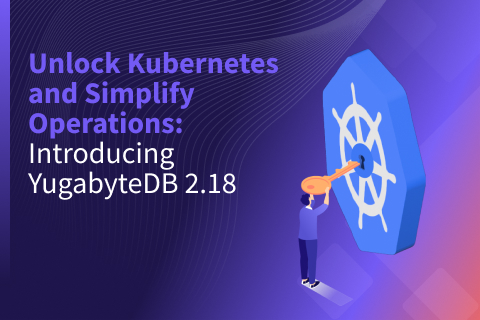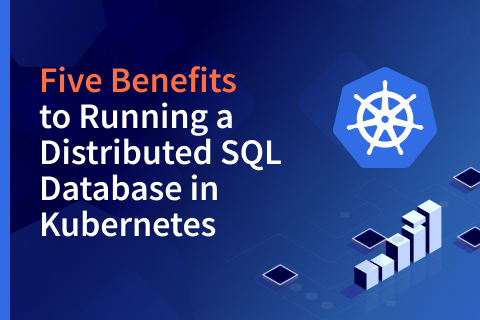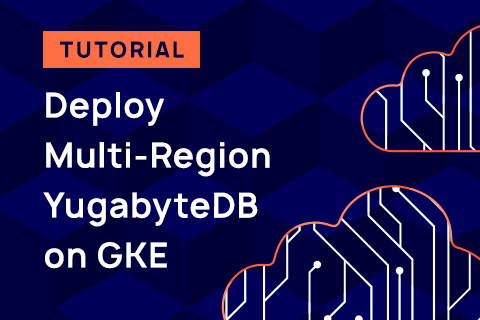YugabyteDB 2.21 Introduces Industry-First Native Orchestration. It’s Disaster Recovery Made Simple.
Data resilience is no longer a luxury, but a necessity. In today’s fast-moving regulatory landscape and unpredictable cloud environments it is crucial that your data remains safe and accessible. However, juggling complex disaster recovery (DR) solutions and legacy database limitations can be a major headache.
Enter YugabyteDB 2.21! This latest release packs a powerful set of new capabilities to further strengthen our built-in resilience.
This new release helps you meet your data resilience requirements by introducing several new capabilities:
- Simplify data resilience and tailor for each workload with native xCluster DR (disaster recovery)
- Accelerate database modernization with full support of Read Committed isolation
- Upgrade software confidently with the new YugabyteDB upgrade rollback
- Reduce risks and automate microservice deployments with a new Kubernetes Operator
Meet xCluster DR: Simplify Operations with Built-in DR Orchestration
The key feature of this release is the new xCluster DR. This is the industry’s first native disaster recovery orchestration solution for a distributed SQL database. It brings together the power of distributed SQL with the proven capabilities of mature DR orchestration solutions.
Say goodbye to clunky third-party tools and enjoy a streamlined, one-click disaster recovery experience!
xCluster DR empowers users to manage their entire DR lifecycle—from initial setup to failover, switchover, and resynchronization—with just a few clicks or simple API commands. This automation simplifies DR operations and minimizes the risk of human error during critical recovery scenarios.
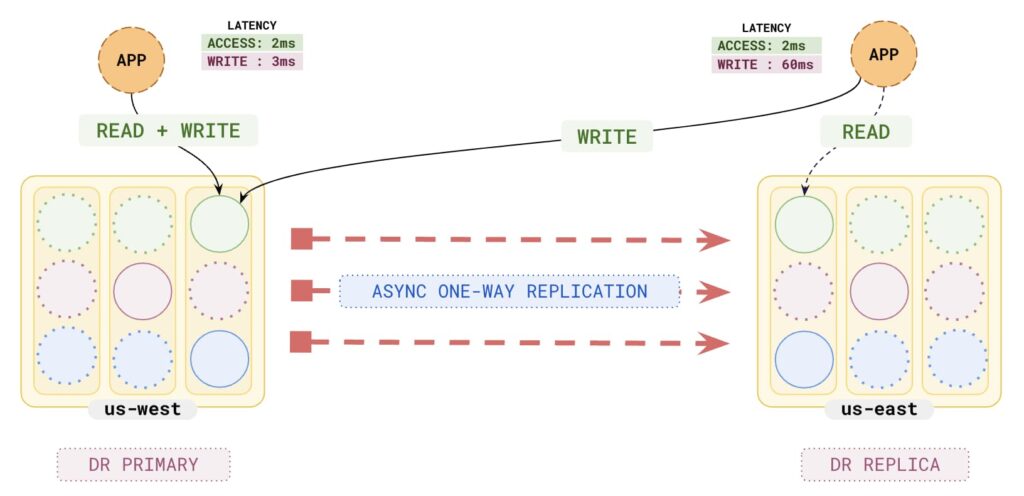
xCluster DR delivers multiple business benefits:
- Simplify Operations and Reduce Costs: Deploy advanced disaster recovery scenarios with minimal clicks, and automate failover and switchover for streamlined operations.
- Accelerate Compliance and Save Time: Meet compliance mandates with ease through simplified DR testing and demonstrations.
- Increase Flexibility and Decrease Risk: Tailor your DR strategy for the optimal balance of resilience and performance with various design patterns.
While YugabyteDB synchronous stretched clusters offer zero Recovery Point Objective (RPO) for apps that require always-on availability, xCluster DR provides a powerful alternative for specific use cases where synchronous replication is not the right fit. This gives you the flexibility to choose the right DR strategy based on the unique requirements of each application.
Key scenarios where xCluster DR is an ideal solution include:
- Limited Regional Availability: In countries that only have one or two available cloud regions, xCluster DR adheres to data residency regulations and offers a compliant DR solution with multi-region protection.
- Long-Distance Latency Concerns: For applications with stringent low-latency requirements, geographically dispersed stretched clusters may not be ideal. xCluster DR provides a strong DR option in such cases.
- Existing DR Knowledge and Processes: Organizations with classic two-data center DR solutions already in place, like Oracle GoldenGate, often require a familiar solution. Existing applications can seamlessly transition to YugabyteDB with xCluster DR and provide a familiar two-data center failover and switchover model, minimizing the need for retraining and process changes.
xCluster Disaster Recovery is not enabled by default. To enable the feature, set the enable disaster recovery Global Configuration option (config key yb.xcluster.dr.enabled) to true.
Once disaster recovery is set up (do this by following the setup instructions in YugabyteDB Docs), the xCluster Disaster Recovery tab allows you to monitor replication and perform key operations:
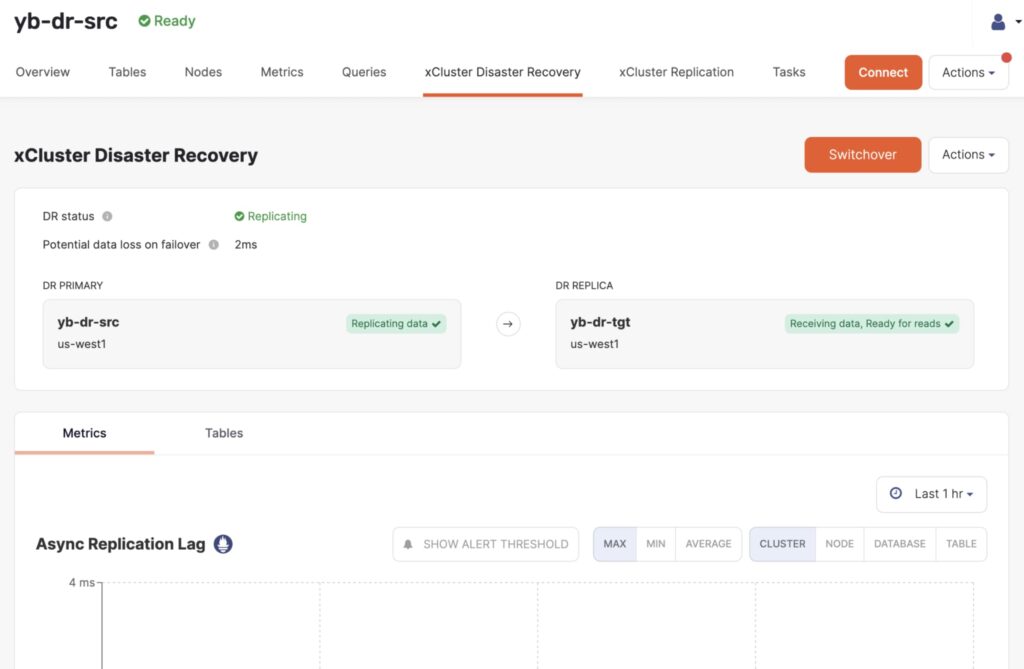
Users can perform failover and switchover actions within the self-managed YugabyteDB Anywhere by navigating to the Actives button and initiating the necessary actions with a single click.
Embrace Read Committed Isolation: Use the Default PostgreSQL Isolation Level in Production
YugabyteDB 2.21 makes migrating applications to a modern, distributed database easier than ever with the general availability of Read Committed isolation.
Read Committed is one of the three isolation levels in PostgreSQL, and also its default.
A unique property of this isolation level is that, for transactions running with this isolation, clients do not need to retry or handle serialization errors (40001) in application logic. The other two isolation levels (Serializable and Repeatable Read) require applications to have retry logic for serialization errors.
This industry-standard isolation level minimizes the need for application code changes when transitioning from popular databases like PostgreSQL, Oracle, and SQL Server. This simplifies the migration process and reduces the risk of errors or compatibility issues during the transition.
Read Committed isolation ensures consistent and predictable application behavior, even during periods of high database activity. This allows developers to focus on building innovative features and functionalities without worrying about unexpected data inconsistencies. Read Committed also offers greater flexibility when balancing data consistency and application performance.
Deploy New Kubernetes Operator: Reduce Risk and Automate Microservice Environments
We are excited to introduce our new open source YugabyteDB Kubernetes Operator, available in Tech Preview (not currently recommended for production use). This powerful new addition for Kubernetes users simplifies the entire lifecycle of your YugabyteDB deployment within a K8s environment.
The YugabyteDB Operator streamlines everything from initial deployment and configuration to ongoing scaling, healing, and backups.
This automation frees up valuable IT resources and ensures a more robust and manageable database environment. Key functionalities include automated deployments, configuration management, self-healing capabilities, backup and recovery options, and seamless integration with GitOps workflows.
The Operator takes complete control of your YugabyteDB instance, managing its entire lifecycle from creation, through upgrades and updates, all the way to deletion if necessary. Beyond high-level workflows like deployment and upgrades, the YugabyteDB Operator allows you to take fine-grained control over your database by exposing configuration flags, CPU and memory limits, and storage class customization options.
By automating complex operations and managing intricate configurations, the YugabyteDB Operator significantly simplifies YugabyteDB deployments within Kubernetes environments. This not only translates to improved reliability, but also allows developers and operations teams to focus their efforts on core functionalities and innovation rather than battling with infrastructure management overhead.
Key benefits of the YugabyteDB Kubernetes Operator include:
- Simplified Operations: Effortlessly manage your distributed database with automated deployments, scaling, and healing.
- Enhanced Resilience: Leverage GitOps workflows and automatic retries to ensure consistent, reliable database operations.
- Streamlined Lifecycle Management: The Operator simplifies stateful workload management, guaranteeing data consistency even during scaling events or failures.
- Simplified Backup and Restore: Custom resources within the Operator enable easy backup and restore functionalities for your databases.
- Automatic Operation Retries: The Operator automatically retries failed operations with an exponential backoff, ensuring your database remains available even in the face of transient infrastructure issues.
- Comprehensive Support Bundles: Generate point-in-time log snapshots for troubleshooting complex issues with ease using the Operator’s support bundle functionality.
Preview Upgrade Rollbacks: Reduce Risk in Adopting the Latest Software
The constant evolution of software necessitates regular database upgrades to use the latest features, and benefit from bug fixes and security patches. However, the software upgrade process itself can introduce unforeseen issues, leading to unexpected behavior or changes in performance.
We are excited to announce our new Upgrade Rollbacks feature, which is available in our latest production release, 2.20.3. This functionality empowers you to confidently embrace new database versions quickly.
The new Upgrade Rollbacks feature is based on a two-phased upgrade process with a built-in rollback window. After initiating the upgrade and successfully completing compatibility checks, the system enters a rollback phase. During this window, you can monitor for alerts or unexpected behavior. If issues are detected, the rollback functionality allows you to seamlessly revert back to the previous stable version, ensuring minimal disruption to your database operations.
Key advantages of the new Upgrade Rollbacks include:
- Reduce Risk: Upgrade rollbacks significantly reduce the risk associated with software updates. This newfound confidence translates to faster adoption of new database versions. You can deploy upgrades containing critical security patches or performance enhancements without hesitation, knowing you can test the software version and then seamlessly revert back to the previous stable version if needed.
- Simplify Troubleshooting: The new capability plays a key role in simplifying troubleshooting. If you encounter an issue following an upgrade, reverting to the previous version effectively isolates the problem. This allows you to pinpoint the root cause of the issue within the specific upgrade itself, streamlining the debugging process.
- Embrace Innovation with Confidence: Upgrade rollbacks empower you to leverage the latest advancements in YugabyteDB with minimal risk. By offering a safety net in the form of rollbacks, database upgrades become more agile and efficient. This allows you to reap the benefits of new features and enhancements while maintaining optimal database performance and application uptime.
Summary and Next Steps
YugabyteDB 2.21 is a game changer for distributed PostgreSQL resilience. By adopting the industry’s first native disaster recovery orchestration, you can ditch related complexity and embrace a streamlined, one-click DR experience. And that’s just the beginning! YugabyteDB 2.21 boasts a suite of features designed to empower confident database upgrades, seamless application modernization, and simplified Kubernetes deployments.
Ready to experience the power and simplicity of YugabyteDB for yourself?
Sign up for our free cloud DBaaS offering today at cloud.yugabyte.com. No credit card required, just pure database innovation waiting to be unleashed!
 Ready to experience the power and simplicity of YugabyteDB for yourself?Sign up for our free cloud DBaaS offering today at cloud.yugabyte.com. No credit card required, just pure database innovation waiting to be unleashed!
Ready to experience the power and simplicity of YugabyteDB for yourself?Sign up for our free cloud DBaaS offering today at cloud.yugabyte.com. No credit card required, just pure database innovation waiting to be unleashed!